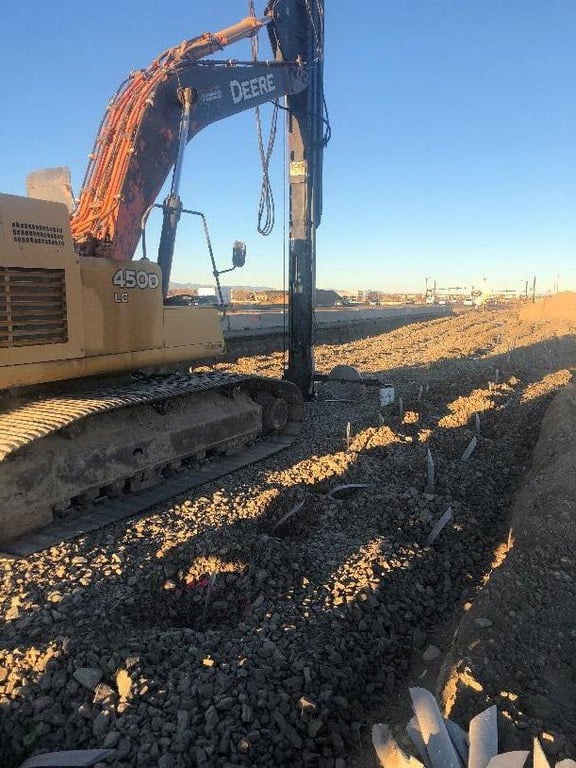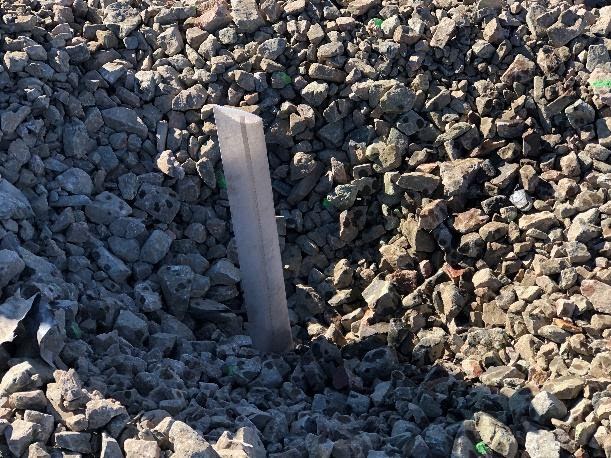Innovative soil compaction process being used near site of future Pueblo West interchange
News Release
PUEBLO— The Colorado Department of Transportation has employed an innovative process to speed up soil compaction on the US 50
Purcell Interchange project.

A wick drain – also known as a prefabricated vertical drain – is a strip of plastic with vertical channels, wrapped in fabric that filters out soil particles and offers groundwater a drainage path. The drains significantly reduce the time it takes to remove moisture from an area of ground, compacting the soil that will be the foundation of the new travel lane on westbound US 50 between Pueblo Boulevard and Purcell Boulevard.
“Placing the wick drains will allow the consolidation to occur
in a matter of months versus years,” says Dan Dahlke, South Program Resident Engineer for CDOT.
The wick drains are hydraulically forced into the ground using equipment referred to as a stitcher, mounted to an excavator as it spools out the drainage strip. The drains will be in place permanently, continuing to wick moisture out of the soil.

Crews have installed 4,795 wick drains -– one third of the drains to be deployed -- to a depth of 8 to 14 feet in the work area for the new interchange over US 50.
More photos and a short video of the wick drain installation process can be found on the project web page: codot.gov/projects/
Stay informed
More information is available at:
Project website: codot.gov/projects/
Project information hotline: 719-789-5099
Project email: [email protected]
Traffic Alerts: Text US50Purcell to 313131. Message and
data rates may apply. Reply STOP to opt out. Terms of Use. Privacy Policy.
Travelers are urged to “know before you go.” Gather information about weather forecasts and anticipated travel impacts and current road conditions prior to hitting the road. CDOT resources include:
-
Road conditions and travel information: COtrip.org
-
Sign up for project or travel alerts: bit.ly/COalerts
-
Connect with us on social media: Twitter @coloradodot and Facebook facebook.com/coloradodot
Remember: Slow for the Cone Zone
The following tips are to help you stay safe while traveling through maintenance and construction work zones.
-
Do not speed in work zones. Obey the posted speed limits.
-
Stay Alert! Expect the unexpected.
-
Watch for workers. Drive with caution.
-
Anticipate lane shifts and merge when directed to do so
-
Expect delays, especially during peak travel times.
-
Allow ample space between you and the car in front of you.
-
Avoid using mobile devices such as phones while driving in work zones.
-
Turn on headlights so that workers and other drivers can see you.
-
Be especially alert at night while driving in work zones.
-
Be patient!
About CDOT
CDOT’s Whole System-Whole Safety program has one simple mission — to get everyone home safely, and our approximately 3,000 employees work tirelessly to reduce the rate and severity of crashes and improve the safety of all modes of transportation. The department manages more than 23,000 lane miles of highway, 3,429 bridges and 35 mountain passes. CDOT also manages grant partnerships with a range of agencies, including metropolitan planning organizations, local governments and airports. It also operates Bustang, the state-owned interregional express bus service. Gov. Jared Polis has charged CDOT to further build on the state’s intermodal mobility options.
